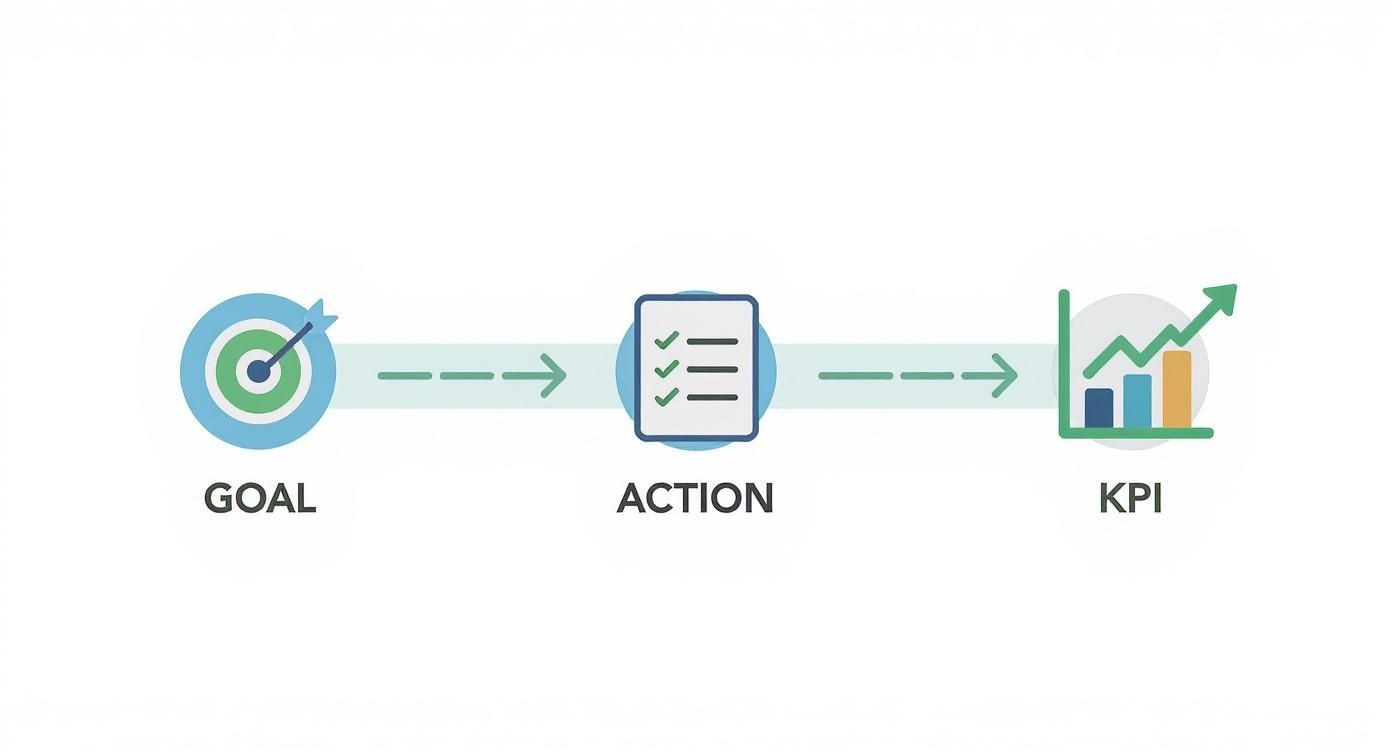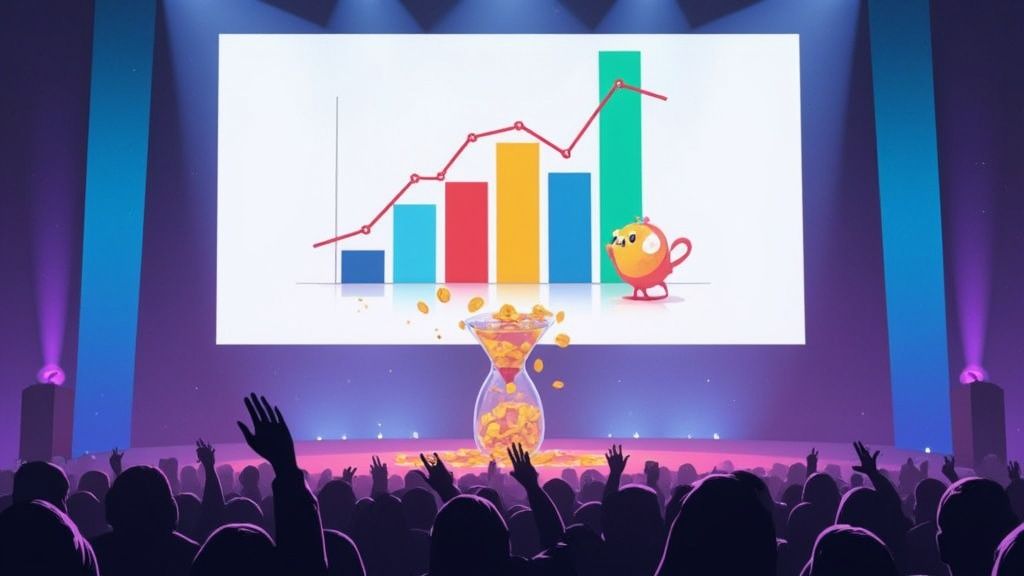Let's be honest, events can feel like a black hole for your budget. You pour in money, time, and resources, but what really comes out the other side? That's where return on investment (ROI) comes in. It’s the simple, powerful calculation that shows you the net value you gained from an event compared to what you spent.
More importantly, it’s the proof you need to show that a well-run event isn't just an expense—it's a strategic asset.
Why Event ROI Is More Than Just a Number
Trying to nail down the ROI of events can feel like trying to catch smoke. You know there’s value there, but pinning it down with hard numbers can be a real headache. Too many organizations see events as just another line item in the marketing budget—a necessary cost for "brand presence," but one whose direct impact on the bottom line stays frustratingly fuzzy.
That whole perspective misses the bigger picture. An event isn’t a one-off marketing stunt; it’s a powerful engine for building real relationships, speeding up the sales cycle, and gathering customer feedback you can't get anywhere else. The moment you shift your mindset from "cost center" to "investment opportunity," you start unlocking its true potential.
The Two Sides of Event Value
Every single event you run generates value in two different—but equally important—ways. You need to get your head around both to see the complete picture of your success.
- Tangible Returns: These are the straightforward, black-and-white metrics you can count on your fingers. Think ticket sales, qualified leads from your booth, or contracts signed on the conference floor. These are the numbers the finance department loves to see.
- Intangible Returns: This is where things get a bit more nuanced, but no less valuable. We're talking about boosts in brand awareness, positive customer sentiment, killer media mentions, and the strengthened relationships that only happen with face-to-face interaction. They're harder to measure, sure, but their long-term impact is massive.
Here's the secret: the intangible gains are what fuel future tangible results. A great brand vibe from today's conference makes for much easier sales calls tomorrow.
Why Measurement Is Non-Negotiable
When it comes time to justify your event budget, feel-good stories aren't going to cut it. A clear, data-backed report on your event ROI is the most powerful tool you have. It lets you prove your worth, secure funding for your next big idea, and make smarter decisions moving forward.
For a deeper look at this, check out our guide on the essential strategies for calculating event marketing ROI.
Beyond just justifying the spend, tracking these metrics helps you get better. By seeing what worked and what flopped, you can refine your strategy for the next event, making each one more effective than the last. This cycle of continuous improvement turns your event program into a reliable growth engine.
And the data doesn't lie. Nearly half of all brands see an ROI between 3:1 and 5:1 on their events. For companies with bigger budgets, a whopping 75% expect to get more than five times their investment back.
Setting Clear Goals and Measurable KPIs
Trying to measure event ROI without clear goals is like starting a road trip with no destination. You'll burn a lot of fuel, but you'll have no idea if you ever got where you were supposed to be. To get a real sense of an event's success, you have to tie every action back to a specific, predefined objective. It’s the foundation of any ROI calculation that actually means something.
Before you print a single banner or send one invitation, you have to ask the most important question: "What do we really want this event to achieve?" The answer to that question will shape every decision you make and give you the framework to prove its value down the line.
Connecting Goals to Actionable Metrics
Different events have different jobs. Some are about generating sales right now, while others are focused on building brand loyalty for the long haul. The trick is to match your main goal with the right Key Performance Indicators (KPIs)—these are the specific, measurable data points that tell you if you're hitting the mark.
Here are a few common event goals:
- Lead Generation: This is a big one, especially for trade shows and webinars. The whole point is to fill your sales pipeline with quality prospects.
- Brand Awareness: Sometimes, the goal is just to get your name out there. You want to boost visibility and influence how people see your brand.
- Customer Education and Retention: For user conferences or workshops, success is all about empowering your existing customers, making them more loyal and encouraging them to use your product more.
- Direct Sales: Think product launches or exclusive pop-up shops. Here, the primary goal is simple: drive revenue on the spot.
Each of these goals needs its own set of KPIs to accurately track the ROI of events. A lead generation goal isn't just about the number of leads; it's about their quality and how much it cost you to get them. For a deeper look at this, our guide on how to measure event success breaks down more strategies for tracking what really matters.
To help you get started, here's a quick look at how you can pair common event goals with the right metrics.
Matching Event Goals to Key ROI Metrics
This table provides a clear framework for connecting common event objectives with the specific KPIs used to measure their financial impact and overall success.
| Event Goal | Primary KPIs | How It Connects to ROI |
|---|---|---|
| Lead Generation | Cost Per Lead (CPL), Lead-to-Customer Conversion Rate | Directly measures the cost-effectiveness of acquiring new business opportunities. |
| Brand Awareness | Social Media Mentions, Website Traffic, Media Impressions | Shows the non-financial return through increased market presence and audience reach. |
| Customer Retention | Product Adoption Rate, Renewal Rate, Customer Satisfaction (CSAT) | Links event activities to long-term customer value and reduced churn. |
| Direct Sales | Revenue Generated, Average Order Value (AOV), Ticket Sales | Provides a straightforward, immediate measure of financial return from the event. |
| Partnership Development | Number of Partner Meetings, Co-Marketing Agreements Signed | Tracks the value of new strategic alliances and future revenue streams. |
By aligning your specific goals with these kinds of KPIs, you stop guessing and start measuring what actually contributes to your bottom line.
Applying the SMART Framework to Your Event Goals
To make sure your goals aren't just wishful thinking, run them through the SMART framework. This simple but powerful tool forces you to get specific and accountable, turning vague ideas into a real plan.
A SMART goal is:
- Specific: Nail down exactly what you want to do. Instead of "get more leads," try "acquire 150 qualified leads from enterprise-level companies."
- Measurable: Define the KPIs you'll use. This could be Cost Per Lead (CPL), Lead-to-Customer Conversion Rate, or the number of Social Media Mentions.
- Achievable: Be ambitious, but be realistic. Look at your budget, your team's bandwidth, and what you’ve accomplished in the past.
- Relevant: Make sure the goal actually supports the bigger picture. Does generating these leads help hit the quarterly sales target?
- Time-bound: Give yourself a deadline. For instance, "achieve this within 30 days post-event."
By framing your objectives within the SMART model, you create a direct line of sight between your event activities and your business's bottom line. Every dollar spent and every hour invested has a clear purpose and a defined metric for success.
This disciplined approach takes all the guesswork out of the equation. You'll know exactly what to track before, during, and after the event. A fuzzy goal like "brand awareness" becomes concrete when you commit to tracking a 20% increase in website traffic from event promos and a 30% rise in social media engagement using the event hashtag. Suddenly, an abstract idea becomes a hard number you can report on, making the ROI conversation a whole lot easier—and more impactful.
The Fundamental Event ROI Formula Explained
Once you have your goals locked in, it's time to talk numbers. Calculating your event ROI isn't some dark art reserved for the finance department; it all boils down to one simple, powerful formula. This little equation is your secret weapon for turning abstract goals into a hard number that tells a story everyone understands.
At its heart, the formula is incredibly straightforward:
Event ROI % = (Net Profit / Total Event Cost) x 100
What you get is a percentage that shows the return you earned for every dollar you put in. For example, a 200% ROI means you made two dollars in profit for every single dollar you spent. But the real magic—and the key to an accurate number—is knowing exactly what to plug into each side of that equation.
Breaking Down Total Event Cost
First things first, you need to get a handle on your "Total Event Cost." This is where a lot of people trip up. It's easy to just count the big-ticket items like the venue or the catering bill, but a true cost analysis goes way deeper to capture every penny you invested.
Think of it like building a house. The final cost isn't just the lumber and concrete. It’s the architect, the permits, the crew's wages, and every last light fixture. Your event is no different. A complete cost picture includes:
- Venue and Logistics: This is the obvious stuff—the physical space, AV gear, food and drinks, and any equipment rentals.
- Marketing and Promotion: Don't forget every dollar you spent getting people in the door. That includes social media ads, email campaigns, content creation, and any flyers or brochures.
- Staffing and Labor: This covers your team's time spent planning and running the event, plus any fees for temporary staff, speakers, or entertainers.
- Technology and Software: Count your event management platform, registration tools, and even services like our service, Add to Calendar PRO, which helps make sure the people who register actually show up.
- Travel and Accommodation: If your team or speakers had to travel, those flights and hotels are a direct event cost.
- Swag and Materials: Any branded goodies, printed agendas, or welcome kits belong in this bucket, too.
Tallying all this up connects your big-picture goals directly to the financial KPIs that prove your event's worth.

This visual really nails the flow: start with a clear goal, define the actions to get there, and then track the key metrics that prove you succeeded.
Calculating Your Event's Net Profit
Now for the fun part: "Net Profit." This is where you add up all the value your event created. The basic math is Total Revenue - Total Event Cost. But "revenue" is more than just what you made on the day. To see the full impact, you have to look at both immediate and future value.
Your total revenue stream is a mix of things like:
- Direct Sales: This one's easy. It’s all the money from ticket sales, sponsorships, or any products you sold at the event.
- Value of New Leads: Not every lead buys on the spot. You need to assign a realistic value to each qualified lead based on your average conversion rate and customer lifetime value (LTV).
- Pipeline Influence: This is huge for B2B events. How many deals already in your sales pipeline moved forward or closed because of a conversation at the event? Track it!
Capturing these different streams of value is what separates a good ROI calculation from a great one.
A Practical Example: A Product Launch Event
Let's make this real with an example. Imagine a software company is hosting a big launch event for its new product.
First, they add up the Total Event Cost:
- Venue & Catering: $15,000
- Marketing & Ads: $5,000
- Staff & Speaker Fees: $7,000
- Technology (including registration and calendar tools): $3,000
- Total Event Cost = $30,000
Next, they calculate the Total Revenue:
- Ticket Sales: $10,000
- New Subscriptions Signed at Event: $25,000
- Value of 50 Qualified Leads (at $500/lead): $25,000
- Total Revenue = $60,000
Now, we can find the Net Profit:
- Net Profit = $60,000 (Revenue) - $30,000 (Cost) = $30,000
And finally, the ROI calculation:
- ROI = ($30,000 / $30,000) x 100 = 100%
A 100% ROI means the company literally doubled its money. That single number tells a powerful story of success. By breaking it down piece by piece like this, you can confidently prove the value of any event you run.
Measuring Both Tangible and Intangible Returns

The real ROI of events isn't just about the sales you close the day after the doors shut. That immediate financial gain is obviously critical, but it's only one piece of a much bigger picture. To get a complete view of your event's success, you need to look at both the hard numbers you can easily count and the softer, yet equally powerful, value that builds your brand's future.
I like to think of it like planting a tree. The tangible return is the fruit you harvest this season—easy to count and taste. The intangible return is the shade it provides, the stronger roots it grows, and the healthier soil it creates, all of which guarantee bigger harvests for years to come. To prove your event's total impact, you have to measure both.
The Tangible Metrics You Can Count
Tangible returns are the straightforward, quantifiable results of your event. These are the metrics that speak directly to your bottom line and are often the easiest to track and report back to your stakeholders. They provide the clear, cold-hard-cash evidence of financial success.
Here are the key tangible metrics to get laser-focused on:
- New Leads Generated: This isn't just about a raw number of scanned badges. It's about tracking how many qualified prospects your event actually pushed into the sales funnel. Quality over quantity, always.
- Conversion Rates: Of all the leads you generated, how many took the next step? This could be anything from scheduling a demo and starting a trial to making a direct purchase.
- Customer Acquisition Cost (CAC): This metric tells you exactly how much it cost to acquire each new customer through your event. A low CAC is a powerful indicator of a seriously efficient event strategy.
- Sales Pipeline Influence: This one is absolutely crucial for B2B events. You need to track how many existing deals in your pipeline were accelerated or closed because of conversations and interactions at the event.
These hard numbers are the bedrock of your ROI calculation. They give you the concrete data you need to justify your budget and show the immediate financial impact to anyone who asks.
Capturing the Intangible Value
Intangible metrics are admittedly trickier to slap a specific dollar value on, but their long-term impact on your business can be absolutely massive. These returns are all about perception, relationships, and brand equity—the very things that make all your future sales efforts easier.
Intangible returns are the emotional and relational capital your event builds. They create the trust and loyalty that tangible metrics like sales figures ultimately depend on.
While you can't always put a price tag on them, you can absolutely measure them. Smart event pros track these less obvious returns using strategies like:
- Brand Sentiment: Use post-event surveys with specific questions about brand perception. Social media monitoring tools can also analyze whether mentions of your brand are positive, negative, or neutral after the event.
- Social Media Engagement: Keep an eye on your unique event hashtag. Track the number of mentions, shares, and comments. A big spike in engagement is a clear sign that you've grown your brand awareness and connected with your audience.
- Press and Media Mentions: Did industry publications or key influencers talk about your event? The value of this earned media can often be worth far more than what you would have paid for equivalent advertising.
- Post-Event Survey Feedback: Go beyond simple "rate your satisfaction" scores. Ask attendees what they learned and how their perception of your brand has changed. Their actual words are a goldmine of insight into your event's real impact.
It’s no secret that investments in live events consistently deliver exceptional marketing value, often outperforming other channels. Research shows companies can see 10 times the ROI from attendees versus non-attendees, which really highlights the incredible quality of event-generated leads. In fact, a whopping 83% of marketers confirm that events are critical for business growth, with 77% rating them as their most effective marketing channel. And with 80% of people ranking in-person events as the most trusted marketing channel, their power to build genuine connections is undeniable. You can dive deeper into these experiential event statistics on Exposure Analytics.
By combining these tangible and intangible metrics, you create a complete and compelling story about your event's success. This balanced approach ensures you capture the full spectrum of value, from immediate revenue to long-term brand health.
Optimizing ROI for Different Types of Events
Not all events are cut from the same cloth. A bustling trade show has goals that look very different from those of an intimate webinar. Measuring both with the same yardstick will only muddy your view of what’s working.
To get a true read on your event ROI, you must match your metrics and tactics to each event’s unique format. Otherwise, you’re like a tailor using a baseball bat to sew a suit—it’s the wrong tool for the job.
Maximizing Returns At Trade Shows
Trade shows thrive on face-to-face energy and spontaneous conversations. Here, you’re not just tallying badge scans; you’re uncovering leads that can turn into multi-thousand-dollar deals.
Focus on:
- Pre-Show Appointment Setting: Reach out to top prospects before the doors open. Lock in one-on-one booth meetings so you’re not waiting on walk-ins.
- Booth Engagement Metrics: Go beyond headcounts. Track product demos delivered, average chat length, and quality scores assigned by your team.
- Targeted Follow-Up: Sort leads immediately. A prospect who asked for pricing needs a different message than someone who only picked up a giveaway. Personalization drives conversions.
Driving Value From Webinars
Webinars demand a laser focus on content and engagement. Your success here hinges on how captivated your audience stays and what steps they take once the session wraps up.
Key tactics include:
- Tracking Attendee Duration: If people bail early, your topic or delivery may need a tune-up.
- Interactive Elements: Polls, live Q&A, and chat aren’t just bells and whistles—they’re windows into attendees’ pain points and priorities.
- Post-Event Content Downloads: Monitor how many participants grab your slide deck, replay the recording, or access follow-up resources. These actions signal genuine interest and buying intent.
Focusing On User Conferences
User conferences are all about your existing customers. While new leads are a nice bonus, your main objectives are education, loyalty, and uncovering upsell or cross-sell opportunities.
For user conferences, success shows up as happier customers and deeper adoption of your product. Lower churn and more renewals are the real ROI.
Optimize with:
- Customer Satisfaction (CSAT) Scores: Send out quick post-event surveys. Pinpoint what delighted attendees and what needs improvement.
- Upsell and Renewal Rates: Track the percentage of attendees who upgrade their plans or renew contracts in the following quarter.
- Product Adoption Metrics: Keep an eye on whether participants start using the new features you spotlighted. This proves your conference added real value.
Trade shows and conferences often deliver the most measurable payback. Data from Fortune 500 companies shows that 14% of these organizations earn $5 for every $1 spent on trade show exhibitions, translating into a 400% ROI. On average, event returns hover between 200% to 500%. Discover more insights about event profitability on Sequel.io and see how strategic planning makes these numbers achievable. By tailoring your approach to each unique format, you can ensure every event delivers the maximum possible return.
Essential Tools to Streamline ROI Tracking
Calculating your event ROI with any real accuracy isn't about getting lost in spreadsheets. It’s about using the right technology to capture clean data and actually prove your impact. Without the right tools, you're just guessing.
Modern event marketers lean on a stack of tools that talk to each other, turning all that raw event data into a clear story of financial return.
Think of these tools like a skilled crew on a ship. Each one has a specific job—from attracting attendees to closing the final deal—but they all work together to get you to your destination: a precise, defensible ROI number.
The Core Technology Stack
Your entire event tracking system is built on a few key platforms.
A Customer Relationship Management (CRM) system, like Salesforce or HubSpot, acts as your single source of truth. It’s where you can see a lead's entire journey, from the moment they register for your event all the way to the day they sign a contract. Making that connection is absolutely critical for attributing real revenue back to your event.
Then you have event management platforms like Cvent or Bizzabo. These handle the nitty-gritty logistics. They're essential for collecting registration numbers, seeing who attended which sessions, and gathering real-time engagement data. This is where you get all the top-of-funnel metrics that feed your bigger ROI analysis.
The right technology doesn’t just measure what happened; it actively improves the outcome. Each tool should not only track a metric but also help you optimize it.
Improving a Foundational Metric: Attendance
Finally, you can't forget the tools that directly improve the attendee experience and, in turn, your most important metrics. Before any ROI calculation can even begin, registrants have to actually show up. This is where our service, Add to Calendar PRO, plays a quiet but powerful role in maximizing the ROI of events.
By making it dead simple for people to add your event to their personal calendars, you immediately cut down on no-show rates. It's a small action that directly boosts your attendance numbers—the foundational metric for every other KPI. After all, a person who doesn't attend can't become a lead, influence a sale, or engage with your brand.
That initial bump in attendance creates a ripple effect, lifting the potential value of every other metric you're tracking. It’s an essential, often overlooked, tool that ensures your event starts with the largest possible pool of engaged participants. For a deeper dive, check out our guide on the different methods of event attendance tracking in our comprehensive guide.
Even after you’ve got the formula down and your tools are ready to go, a few questions about event ROI always seem to pop up. Let's dig into the most common ones so you can measure your event's success with total confidence.
What Is a Good ROI for an Event?
This is the million-dollar question, isn't it? But there's no single magic number. What counts as "good" ROI is completely tied to your goals, your industry, and the type of event you're running.
For a big trade show focused on lead generation, you might be aiming for a 300-500% return. That means for every dollar you put in, you want to see three to five dollars in new pipeline value coming out. Easy enough.
But what about a user conference designed to build customer loyalty? Its direct financial return might look much lower, but if it slashes your customer churn rate, it’s a massive win. The best benchmark is always your own past performance and the specific targets you set beforehand.
How Do I Measure ROI for a Virtual or Hybrid Event?
Measuring ROI for virtual and hybrid events uses the exact same core ideas, but you'll be leaning much more heavily on digital engagement metrics. The costs look different—less on the venue, more on the tech platform—and you're tracking value through online interactions instead of handshakes.
Think about metrics like:
- Attendee Engagement: How long did people stick around for a session? Did they participate in polls? How many downloaded your resources?
- Digital Lead Capture: This is where registration forms and interactions in virtual booths become your goldmine for lead data.
- On-Demand Views: Don't forget the long tail. The value of your content continues to grow as people watch recordings long after the live event is over.
How Long After an Event Should I Measure ROI?
Event ROI isn’t something you calculate the day after the confetti settles. The true impact takes time to unfold, especially in the B2B world where sales cycles can be painfully long.
A much better approach is to measure in stages:
- The Quick Wins (1-2 weeks post-event): This is when you tally up the immediate stuff—direct sales, new qualified leads, and social media buzz.
- The Mid-Game (3-6 months post-event): Now you can start tracking how many of those leads are actually converting into customers and see the event's influence on your pipeline.
- The Long Haul (12+ months post-event): This is where you analyze the big picture, like the customer lifetime value (LTV) and renewal rates for customers who came from that event.
Breaking it down this way gives you a complete story, showing off both the instant wins and the lasting impact on your business.
Maximizing your event's potential starts with getting people to actually show up. Add to Calendar PRO makes it effortless for attendees to remember your event, boosting attendance and providing a stronger foundation for a great ROI. See how our service can help at https://add-to-calendar-pro.com.



